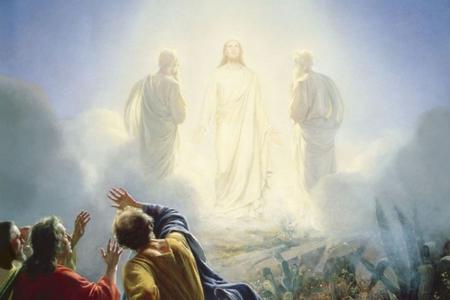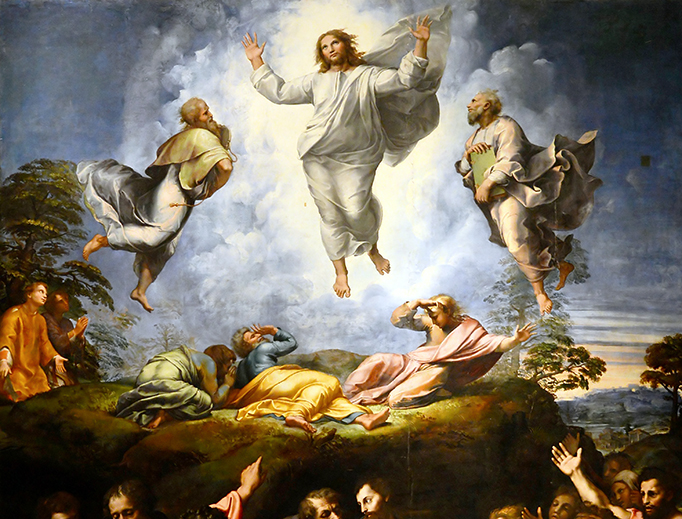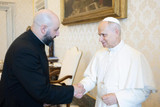What is the Transfiguration?
Originally published by www.EWTN.com
The Transfiguration of Jesus is one of the key events in Jesus’ life. He took three apostles – Peter, James, and John – up to a high mountain to pray. As they were praying, His appearance changed, and His clothes became “dazzling white.” At that point, Moses and Elijah appeared and spoke to the Lord about His upcoming death. A cloud overshadowed the group, and God the Father’s voice came from the cloud saying, “This is my Son, my Chosen; listen to him!”
The Church celebrates the Feast of the Transfiguration each year on August 6.
What was the reason for the Transfiguration?
According to St. Thomas Aquinas, the Transfiguration occurred because the divine glory which was Christ’s was allowed for a moment to shine through His human body. He did this so that they could taste for a short time the contemplation of eternal joy, in view of the persecutions they would suffer.
What does “transfiguration” mean?
Transfiguration refers to Our Lord’s change in appearance from the passable bodily form in which He would suffer and die, to the glorified form in which He would rise from the dead. The Latin root “trans-“ means “across” or “through.” The root “figura” means “form” or “shape.”
When did the Transfiguration happen?

This event happened approximately a week after Jesus and the disciples went to Cæsarea Philippi, which is where Peter declared that Jesus was “the Christ of God” (Luke 9:20).
Regarding the timeline of the Gospel events, the Catechism says, “On the threshold of the public life: the baptism; on the threshold of the Passover: the Transfiguration” (CCC 556). The Transfiguration did not happen immediately before Jesus’ Passion, but it is believed to be later in His ministry.
Where did the Transfiguration take place?
Although the Gospels only refer to it as a “high mountain,” according to tradition it was on Mount Tabor in Israel. Not too far from Nazareth, a Franciscan church commemorates the traditional site, where 4th century and 12th century churches had previously existed.
Who witnessed the Transfiguration?
The apostles Peter, James, and John witnessed this event. Pope Benedict XVI said:
The mystery of the Transfiguration must not be separated from the context of the path Jesus is following. He is now decisively oriented to fulfilling His mission, knowing all too well that to arrive at the Resurrection He must pass through the Passion and death on the Cross. He had spoken openly of this to His disciples; but they did not understand, on the contrary they rejected this prospect because they were not reasoning in accordance with God, but in accordance with men (cf. Mt 16:23).
It is for this reason that Jesus takes three of them with Him up the mountain and reveals His divine glory, the splendour of Truth and of Love. Jesus wants this light to illuminate their hearts when they pass through the thick darkness of His Passion and death, when the folly of the Cross becomes unbearable to them. God is light, and Jesus wishes to give His closest friends the experience of this light which dwells within Him.
What is significant about Moses and Elijah's appearance at the Transfiguration?
In Matthew 5:17, Jesus says, “Think not that I have come to abolish the law and the prophets; I have come not to abolish them but to fulfil them.” The Law and the Prophets are the two main aspects of the Old Covenant, and Moses represents the Law, while Elijah represents the Prophets.
Was the Holy Spirit present at the Transfiguration?
Yes, all three Persons of the Most Blessed Trinity were present at the Transfiguration. St. Thomas Aquinas said, "The whole Trinity appeared: the Father in the voice; the Son in the man; the Spirit in the shining cloud."
Where is the Transfiguration in the Bible?
All three Synoptic Gospels highlight the Transfiguration (Matthew 17:1–8, Mark 9:2–8, and Luke 9:28–36).
This is the account from the Gospel of Luke:
Now about eight days after these sayings he took with him Peter and John and James, and went up on the mountain to pray. And as he was praying, the appearance of his countenance was altered, and his raiment became dazzling white. And behold, two men talked with him, Moses and Eli′jah, who appeared in glory and spoke of his departure, which he was to accomplish at Jerusalem. Now Peter and those who were with him were heavy with sleep but kept awake, and they saw his glory and the two men who stood with him. And as the men were parting from him, Peter said to Jesus, “Master, it is well that we are here; let us make three booths, one for you and one for Moses and one for Eli′jah”—not knowing what he said. As he said this, a cloud came and overshadowed them; and they were afraid as they entered the cloud. And a voice came out of the cloud, saying, “This is my Son, my Chosen; listen to him!” And when the voice had spoken, Jesus was found alone. And they kept silence and told no one in those days anything of what they had seen.
What does the Transfiguration teach us?
St. John Paul II said,
We, pilgrims on earth, are granted to rejoice in the company of the transfigured Lord when we immerse ourselves in the things of above through prayer and the celebration of the divine mysteries. But, like the disciples, we too must descend from Tabor into daily life where human events challenge our faith. On the mountain we saw; on the paths of life we are asked tirelessly to proclaim the Gospel which illuminates the steps of believers.
Likewise, Pope Francis said,
From the event of the Transfiguration I would like to take two significant elements that can be summed up in two words: ascent and descent. We all need to go apart, to ascend the mountain in a space of silence, to find ourselves and better perceive the voice of the Lord. This we do in prayer. But we cannot stay there! Encounter with God in prayer inspires us anew to “descend the mountain” and return to the plain where we meet many brothers weighed down by fatigue, sickness, injustice, ignorance, poverty both material and spiritual. To these brothers in difficulty, we are called to bear the fruit of that experience with God, by sharing the grace we have received.

The Narrow Gate Blog
Fr Ben meets Pope Leo
Originally published by catholicweekly.com.au Fr Ben Saliba, master of ceremonies for Archbisho...
Catholic social media runs red-hot for “new” Shroud of Turin research
Originally published by Catholicweekly.com.auThe Catholic world has finally caught up with The Catho...
A Drop in the Ocean
written by Cath GaleAfter caring for my Dad full time for 14 months, while he lived with a brain tum...
The miraculous making of MacKillop docu-film
Originally published by The Catholic Weekly When pre-production began on a docu-fict...
The Assumption of Mary in History
This article first appeared at: catholic.com. The doctrine of the Assumption of Mary began with...
What is the Transfiguration?
Originally published by www.EWTN.com The Transfiguration of Jesus is one of the key events in Jesus’...






